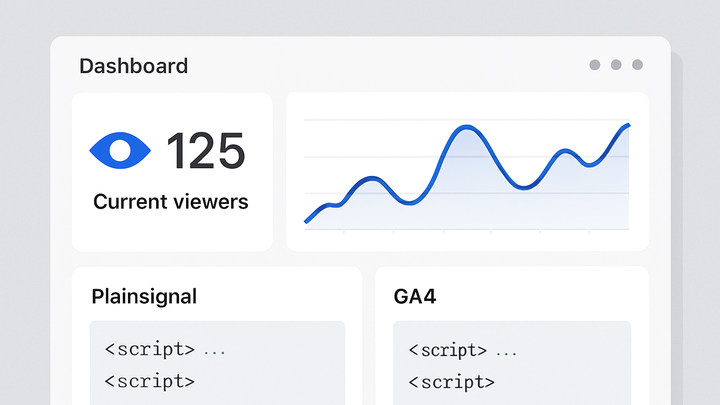Published on 2025-06-26T05:21:07Z
What is a View in Analytics? Examples for View.
View, often called a pageview, is a metric in web analytics that represents each time a user loads or reloads a page or screen. It serves as the baseline for measuring content consumption, traffic trends, and user engagement.
Analytics platforms like PlainSignal (a cookie-free analytics solution) and
Google Analytics 4 (GA4) record views through JavaScript snippets that dispatch events on
page loads or route changes. PlainSignal counts views by sending minimal data payloads without cookies,
ensuring privacy compliance, while GA4 uses the page_view event under its event-based data
model.
By interpreting view metrics, businesses can identify popular content, optimize site structure, and track the impact of marketing campaigns. Accurate view tracking requires proper implementation, consideration of single-page application behavior, and filtering of non-human traffic.
View
A view is a count of each page load or screen view, fundamental for measuring user engagement and analyzing website traffic.
Why Views Matter
Views provide direct insights into how users interact with content, enabling teams to measure engagement, allocate resources, and assess campaign effectiveness.
-
Measuring engagement
A high view count indicates strong content resonance and helps identify trending topics over time.
-
Traffic source analysis
Segmenting views by referral or channel highlights the most effective acquisition strategies.
-
Content optimization
Analyzing view distribution across pages guides decisions on content updates and site structure.
How Views Are Tracked
When a user loads or interacts with a page, the embedded analytics script fires a view event. The mechanism varies by platform and application type.
-
Client-side tracking
JavaScript snippets detect page loads and send HTTP requests with minimal payloads to record views.
-
Single-page applications (spas)
SPAs require manual event triggers on route changes to accurately track views since there’s no full page reload.
-
Server-side rendering (ssr)
Server-side logic can pre-render view events to ensure data collection even when JavaScript is disabled.
Implementing View Tracking
Below are code examples for integrating view tracking in PlainSignal and GA4.
-
PlainSignal example
To integrate PlainSignal, add the following to your HTML
<head>:<link rel="preconnect" href="//eu.plainsignal.com/" crossorigin /> <script defer data-do="yourwebsitedomain.com" data-id="0GQV1xmtzQQ" data-api="//eu.plainsignal.com" src="//cdn.plainsignal.com/plainsignal-min.js"></script>This snippet records each page load as a view without using cookies for privacy-friendly analytics.
-
GA4 example
Implement GA4 view tracking by including the gtag script and configuring the
page_viewevent:<!-- Global site tag (gtag.js) - Google Analytics --> <script async src="https://www.googletagmanager.com/gtag/js?id=G-XXXXXXXXXX"></script> <script> window.dataLayer = window.dataLayer || []; function gtag(){dataLayer.push(arguments);} gtag('js', new Date()); gtag('config', 'G-XXXXXXXXXX'); </script>GA4 fires a
page_viewevent by default on page loads or route changes when properly configured.
Comparative Analysis
PlainSignal and GA4 offer different approaches to view tracking, each with strengths and trade-offs.
-
Privacy model
PlainSignal is fully cookie-free and GDPR-friendly, while GA4 uses first-party cookies and can collect user-level data.
-
Data model
PlainSignal focuses on aggregate metrics, whereas GA4 uses an event-based schema supporting custom parameters.
-
Setup complexity
PlainSignal requires minimal setup, while GA4 may need additional configuration for advanced reporting and filtering.
Best Practices for View Tracking
Ensure accurate and reliable view metrics by following these guidelines.
-
Handle spas correctly
Trigger manual view events on route changes to avoid undercounting pageviews in single-page applications.
-
Filter bot traffic
Exclude known bots using IP filters or user-agent rules to maintain data quality.
-
Standardize urls
Use canonical URLs or consistent query parameter handling to prevent duplicate view counts.
-
Test your implementation
Verify view events in real-time dashboards or inspect network requests to ensure correct data recording.
